The AMD Trinity Review (A10-4600M): A New Hope
by Jarred Walton on May 15, 2012 12:00 AM ESTAMD Trinity Gaming Performance
After the 3DMark results, you might be wondering if Intel has finally caught up to AMD in terms of integrated graphics performance. The answer is…yes and no. Depending on the game, there are times where a fast Ivy Bridge CPU with HD 4000 will actually beat out Trinity; there are also times where Intel’s IGP really struggles to keep pace. The good news is that at least everyone is now onboard the DX11 bandwagon, and compatibility with games has improved yet again for Intel. Here are our “Value” benchmark results for seven recent games; we’ll have more information in a moment.

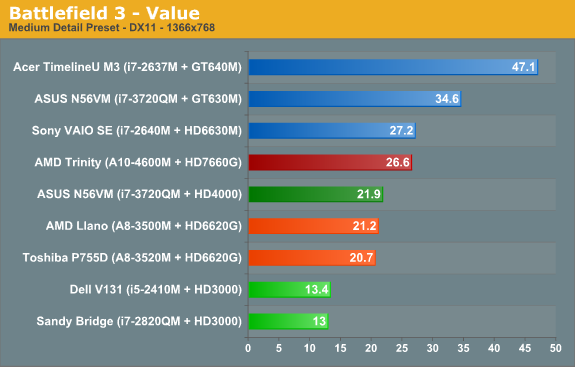
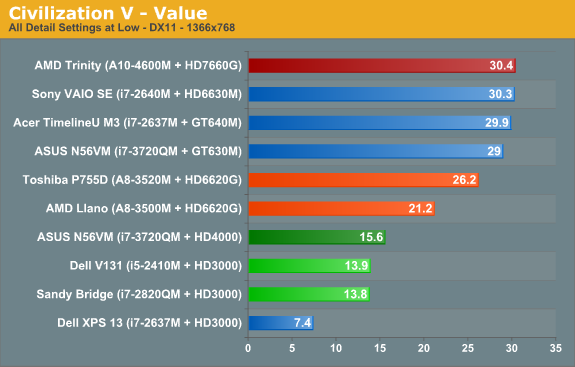

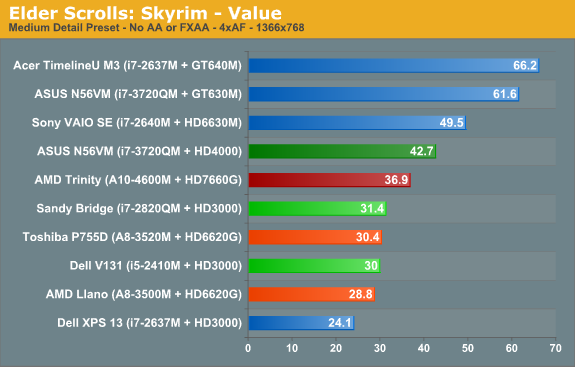
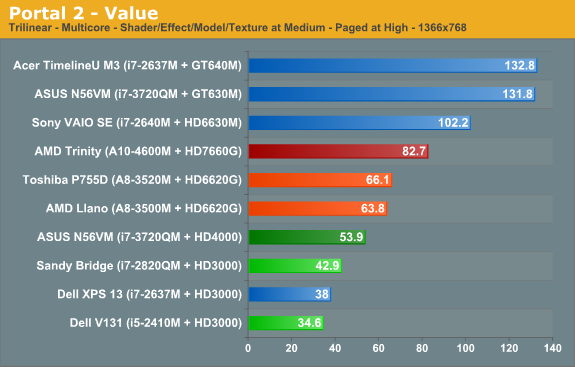
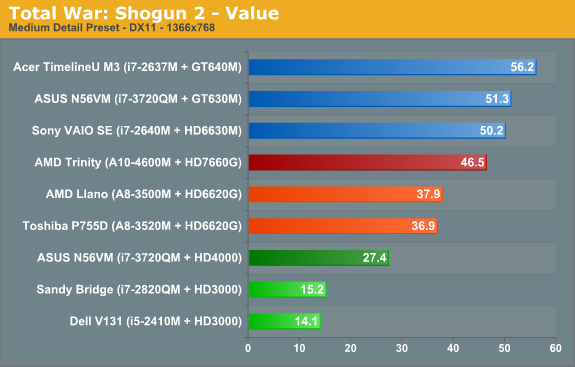
Out of our seven test titles, AMD’s Trinity leads any other IGP in four titles by a large margin. The other three titles actually have Ivy Bridge slightly ahead of Trinity, but the gaps aren’t nearly as big. Overall, the average performance across the seven games at our Value (medium) settings has AMD’s Trinity A10-4600M leading Intel’s i7-3720QM by 21%, and if we look at quad-core Sandy Bridge with HD 3000 (i7-2820QM) Trinity is 72% faster. Trinity is also around 20% faster than 35W Llano on average.
Let’s expand our gaming suite just a bit to see if things change, though. Just like we did with Ivy Bridge, we ran the eight games in our previous benchmark suite at medium detail settings. We can then compare performance across a wider 15 title selection to see how Trinity matches up against HD 4000, HD 3000, and HD 6620G (Llano). We’ll start with the bottom (HD 3000/Sandy Bridge) and move up.
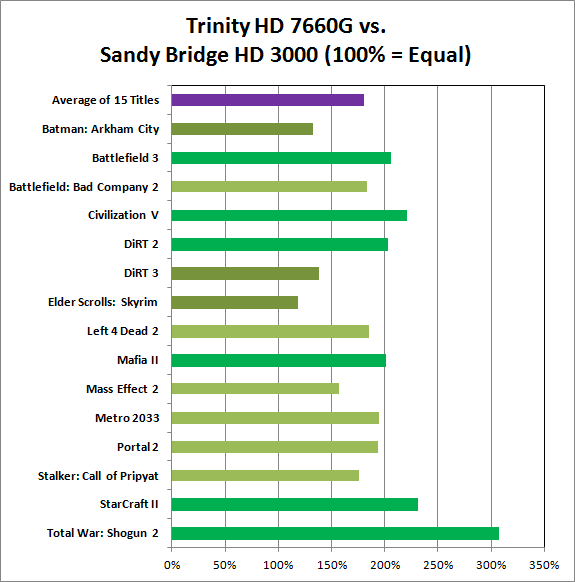
Llano’s HD 6620G was already faster than HD 3000, and Trinity’s HD 7660G is faster than Llano, so the Sandy Bridge gaming matchup is a landslide victory in AMD’s favor. The closest Intel can get is in the same three titles where Ivy Bridge leads Trinity: Batman: Arkham City, DiRT 3, and Skyrim. Here, however, HD 3000 can’t actually close the gap and HD 6620G is at least 20% faster than HD 3000, with an average performance improvement of nearly 80%.
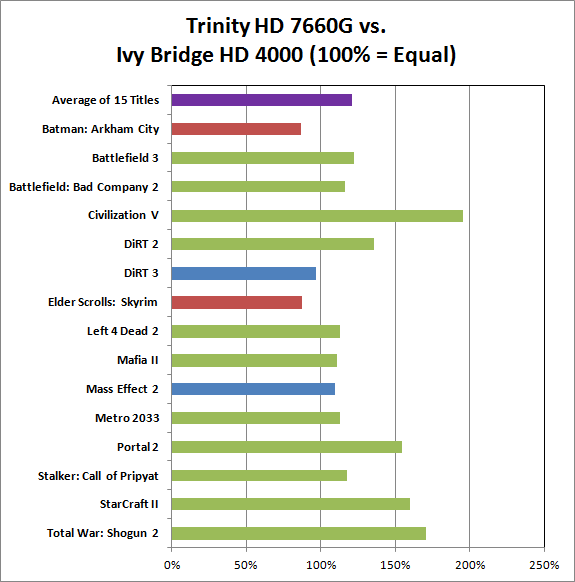
We found that across the same selection of 15 titles, Ivy Bridge and Llano actually ended up “tied”—Intel led in some games, AMD in others, but on average the two IGPs offered similar performance. This chart and the next chart will thus show a similar average increase in performance for Trinity, but the details in specific games are going to be different. Starting with Ivy Bridge and HD 4000, as with our earlier game charts we see there are some titles where Intel leads (Batman and Skyrim), a couple ties (DiRT 3 and Mass Effect 2), and the remainder of the games are faster on Trinity. Mafia II is close to our <10% “tie” range but comes in just above that mark, as do Left 4 Dead 2 and Metro 2033. The biggest gap is Civilization V, where Intel’s various IGPs have never managed good performance; Trinity is nearly twice as fast as Ivy Bridge in that title. Overall, it's a 20% lead for Trinity vs. quad-core Ivy Bridge.
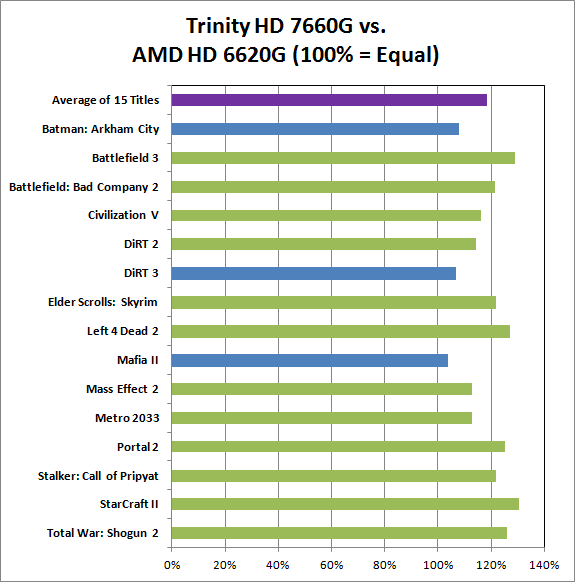
Against Llano, Trinity is universally faster, but the smallest gap is in Mafia II (3%) while the largest gap is in StarCraft II (30%). On average, looking at these games Trinity is only 18% faster than Llano. What’s not entirely clear from the above chart is whether we’re hitting CPU limitations, memory bandwidth limitations (remember that Llano and Trinity share bandwidth with the rest of the system), or perhaps both. At our chosen settings, what is clear is that Trinity’s “up to 56% faster” graphics never make it that high.
We saw 35-45% higher scores in 3DMark 11 and Vantage, which tend to remove the CPU from the equation more than actual games, so our guess would be that if AMD continues with their APU plan they’re going to need to work more on the CPU side of the equation. We also see the same thing looking at the VAIO SE scores in the earlier gaming charts: the HD 6630M scores are 20% faster on average, but much of that appears to come from the faster CPU rather than the GPU.










271 Comments
View All Comments
mdeo - Tuesday, May 15, 2012 - link
" For some of these applications, we don’t have any good way of measuring performance across a wide selection of hardware, and for some of those where benchmarks are possible I’ve run out of time to try to put anything concrete together"Please wait and spend the required time before you post results.
Also, where are the graphs for WinZip, GIMP filters (19 of them ..you deemed 5 that you would use). Graphs make it easy to read that Trinity beats Intel chips in GIMP and equals in WinZip.
This makes me wonder why should I trust Anandtech more then tomshardware reviews ...
JarredWalton - Tuesday, May 15, 2012 - link
You apparently have no idea how much time goes into putting together a review and running all the benchmarks. Let's just say that after running (and rerunning) benchmarks for much of the last month on a variety of laptops, I finished a couple of graphs right at the 12:01 AM NDA time. That was after getting about ten hours of sleep total over the weekend, and never mind the fact that I've had a horrible cold the past week.Every new benchmark needs to be created and evaluated to see if it's useful. GIMP's new "Noise Reduction" and "Blur" functions can use OpenCL, but so can "Checkerboard". Um, really? We need OpenCL to fill an image with a checkerboard?
Here are a few GIMP numbers (from Noise Reduction):
A10 CPU: .396 MP/s
A10 OCL: 4.10 MP/s
IVB CPU: 1.49 MP/s
IVB OCL: 4.04 MP/s
SNB CPU: .689 MP/s
SNB OCL: 3.56 MP/s
DC SNB CPU: .586 MP/s
DC SNB OCL: 2.01 MP/s
Llano CPU: .321 MP/s
Llano OCL: 2.39 MP/s
I had a graph for WinZip, but then we pulled it because apparently WinZip's OpenCL performance is best using the legacy compression. I used their newer Zipx compression, which results in a smaller file but isn't as optimized (yet). So now I need to spend about two hours retesting WinZip and 7-zip. Thanks for understanding.
Beenthere - Tuesday, May 15, 2012 - link
As expected Trinity delivers in all areas and should meet most people's needs quite well. Good job AMD. You get my money!tipoo - Tuesday, May 15, 2012 - link
I wonder what causes these odd results? The 7660 winning by a wide margin in most games, but losing by a small margin in some? Is it whether the games are pixel fill vs pixel shader (hd4000 is good at the former, bad at the latter) bound, or is there a driver issue with the 4000, or what?Wolfpup - Tuesday, May 15, 2012 - link
That has to be the most surprising thing in the review to me. While I know technically today's GPUs are really CPUs geared towards less branchy, more parallel code, it still caught me off guard that someone had thought to run a file compression utility on it!Also surprised Intel has OpenCL drivers at all...not surprised they're bad though. I wonder what they do? Like is their "GPU" portion of Sandy/Ivy bridge actually capable of doing that type of work, or are they mostly just using the CPU?
Still hate "quicksync" and the graphics portion of those CPUs as it's wasting at least enough transistors for a 5th core.
jwcalla - Tuesday, May 15, 2012 - link
File compression can be parallelized, but there are some unfortunate limitations... final compressed size is generally less optimal with parallel compression, and compressing large volumes of data become memory-bound fairly quickly. But for "ordinary" compression tasks it's quite effective.The article didn't indicate if the CPU compression tests were single-threaded or multi-threaded.
Brazos - Tuesday, May 15, 2012 - link
Can I assume the improvements seen here will be implemented in the next version of Bulldozer (Vishera)?mikato - Wednesday, May 16, 2012 - link
Yes, it's supposed to use Piledriver modules, not Bulldozer.silverblue - Thursday, May 17, 2012 - link
Plus even the Piledriver implementation in Trinity should, clock for clock, be faster than Bulldozer even without L3 cache. This isn't a repeat of Llano vs. Phenom II where Husky cores were technically faster than Stars albeit lacked L3 cache which brought the performance back down again.Some information about the caches plus their latency would be really appreciated; if it bodes well here, Vishera might be a very decent chip.
jwcalla - Tuesday, May 15, 2012 - link
Is there really a large market for gaming on a lower-end laptop? I can see us techies being interested in that sort of thing, but what percentage of PC buyers is actually concerned about gaming performance, let alone on a laptop? In real world terms, I'm not seeing AMD's strategy giving it much of an advantage.I'm willing to entertain the reality that Intel has been "overselling performance" to casual users for some time now, and so maybe low-end is more than good enough... but, if true, AMD seems to be focusing on a segment that is going to have an enormous amount of competition in the next 2-3 years.